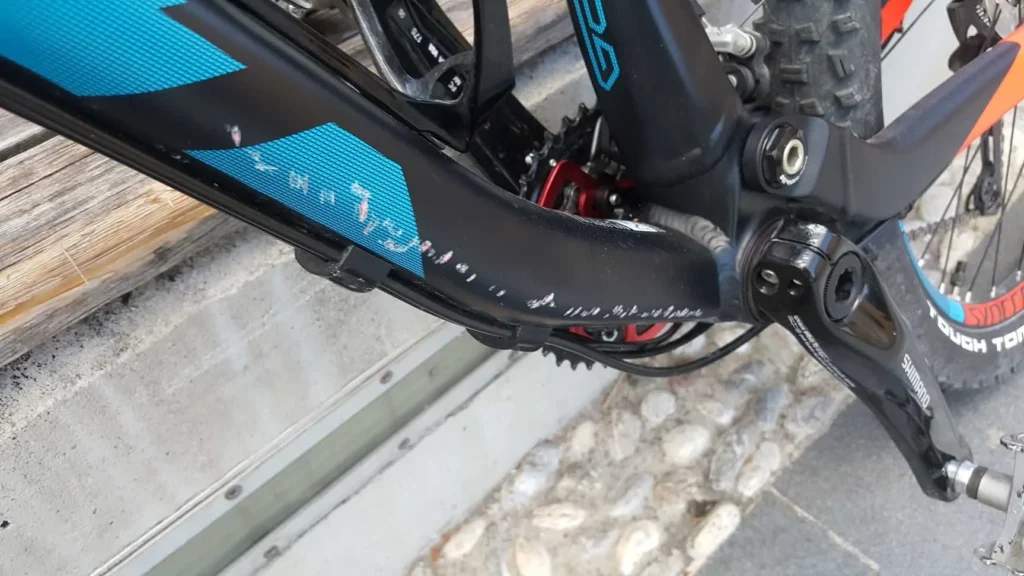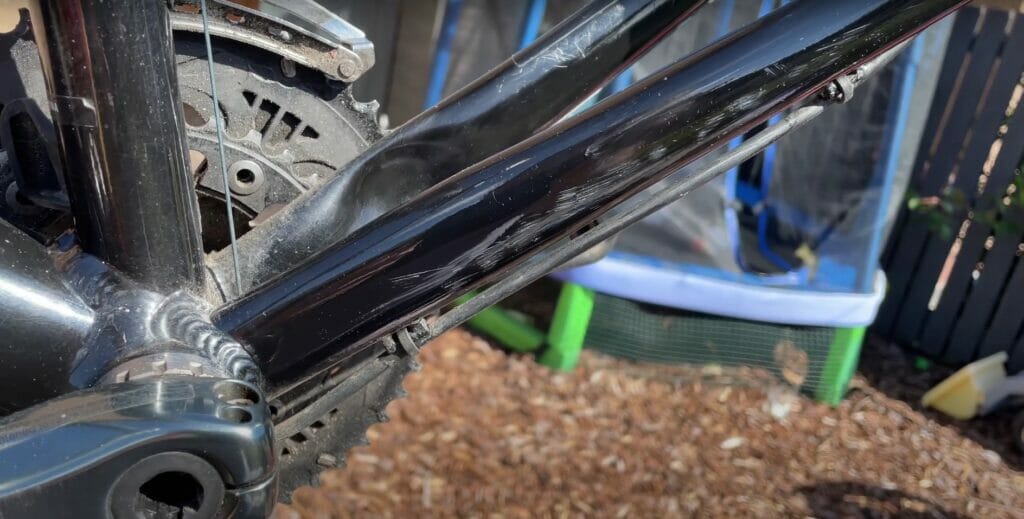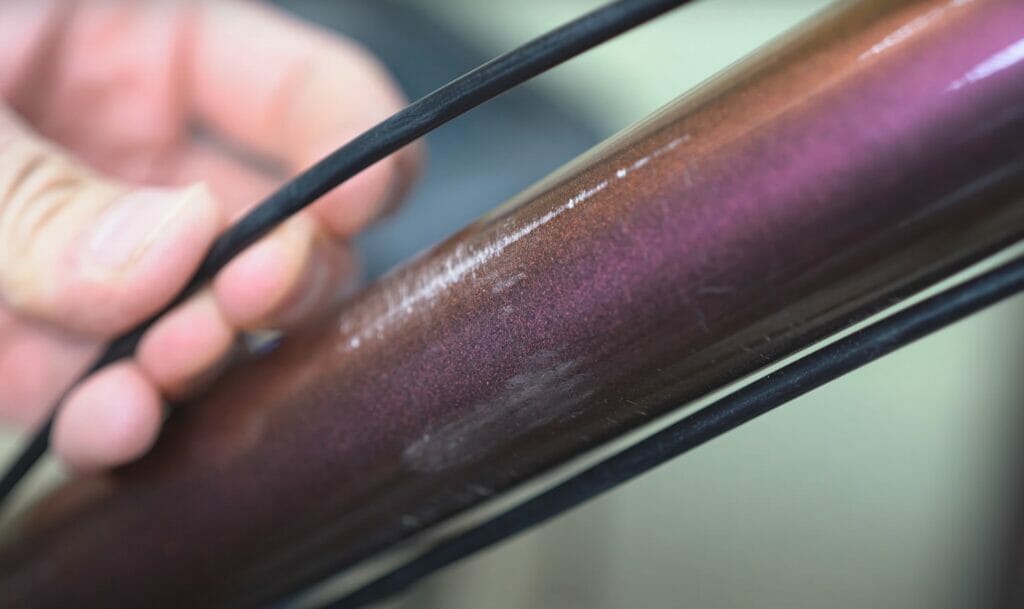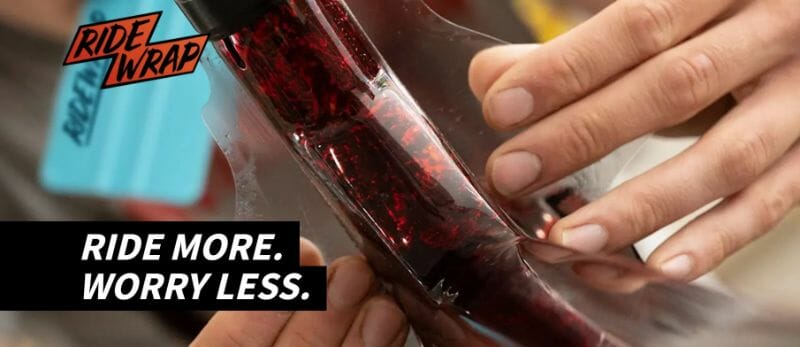Do Mountain Bikes Get Scratched? Tips To Minimize Scratches and Chips

If you’re an avid mountain biker, you know that scratches and chips on your bike are inevitable.
Yes, mountain bikes get scratched all the time. When riding on rough terrains or encountering obstacles, the bike’s frame, fork, and other components may come into contact with rocks, branches, or other abrasive surfaces, leading to scratches.
But fear not, there are ways to minimize the damage and keep your mountain bike looking pristine for longer.
Below, I’ll share some tips and tricks on how to prevent and minimize scratches and chips on your mountain bike.
From investing in a protective kit to proper maintenance and cleaning techniques, you’ll learn how to keep your bike looking as good as new.
Why Do Mountain Bikes Get Scratched?
Mountain bikes can get scratched for several reasons. The main reason for scratches is the dangerous and challenging terrain they navigate, where branches, rocks, and overgrown shrubs can leave unsightly marks.
Transporting the bike can also lead to accidental bumps and scrapes.
As I washed my bike, I kept finding paint chips and scratches everywhere.
There were two big paint chips near the rear dropout where my derailleur had smashed into the frame after it broke

When thinking about why these marks form over time when you’re out having fun riding your bike, it’s important to recognize that bikes are meant to be used.
Wear and tear can happen from some of the harshest conditions or a simple crash in a parking lot.
Even so, these chips and scratches are battle scars earned while pushing our machines to their limits in search of adventure.
Types of Bike Scratches
Scratches are an inevitable reality in the mountain biking realm.
These marks can range from minor surface scratches to deep dents that compromise the structural integrity of the frame.
Understanding the different types of bike scratches can help riders better assess the extent of damage and take appropriate steps to address them.


From simple touch-up paint for light scratches to more extensive repair services for deep scratches, there are various options available to restore the bike’s appearance. We will explore these methods at the end of this article.
Are Scratches and Chips Safe for Carbon Frames?
Carbon frames are incredibly lightweight and strong, thanks to the use of carbon fiber materials.
However, they are also more vulnerable to impact compared to other frame materials like aluminum or steel.
Even light scratches or chips on a carbon frame can weaken its structural integrity, leading to potential failure over time.
To ensure the safety and longevity of your carbon frame, it is crucial to get any scratches or chips inspected by a professional.
They usually inspect carbon frames using an electronic digital tap hammer. This is the same tool used by technicians in the aerospace industry.
These guys will assess the depth and severity of the damage and determine whether any underlying structural issues need to be addressed.
Ignoring these seemingly minor imperfections can result in catastrophic failure while riding.
Preventing Scratches and Chips on Mountain Bikes
Preventing scratches and chips on your mountain bike is essential for both its appearance and longevity.
Here are some ways to minimize scratches on your bike:
Below we will explore each of these preventative measures so you can enjoy your mountain biking adventures while keeping your bike safe from unnecessary damage.
1. Investing in Frame Protection
Investing in frame protection is a wise choice to prevent scratches and chips on your mountain bike. There are various options available:
Frame Protection Stickers
These stickers are made of high-quality adhesive PVC to cover susceptible areas of the frame and provide an extra layer of protection. They have a unique look and feel and can withstand impact and cable rubbing.
They come in many cool graphics and designs that can improve the look of your bike frame protection while adding a personal touch to it. Apply it from day one to keep your bike frame scratch-free.
DyedBro has a wide range of stickers for different kinds of bikes, frames, and parts.
Frame Protection Kits
Frame protection kits (bike protection films) are comprehensive sets of protective materials and accessories that are designed to safeguard vulnerable areas of a bike frame from scratches, scuffs, stone chips, and other forms of damage.
Using a frame protection kit, like one from RideWrap, is an affordable and effective way to keep your mountain bike frame looking new and maintain its resale value.

Here are some of the frame protection kit benefits:
2. Proper Storage & Transporting

To keep your bicycle in top shape and protect it from scratches and damage, proper storage and transportation are vital.
3. Paint Job
Having a top-notch paint job is a must for any mountain bike. It’s not just about looks, but also about safeguarding against scratches and harm.
Gloss and matte paint are the two main options commonly used.
Gloss Paint
Glossy paint is a top choice for mountain bikes because of its amazing qualities and long-lasting nature. This type of paint gives your bike a shiny and reflective finish that adds depth and dimension to its look. The glossy surface creates an illusion of depth, making the colors vibrant and eye-catching.
In terms of durability, glossy paint can withstand the elements and resist minor scratches and scuffs. It’s often paired with a clear coat for extra protection against UV rays and to enhance its durability.
However, glossy paint does have its drawbacks. Over time, it may fade due to prolonged exposure to sunlight and other environmental factors. It’s also more prone to chips and cracks compared to matte paint because the smooth surface reflects light and makes imperfections more noticeable.
Below is a recap of gloss paint’s pros and cons:
Pros
Cons
Matte Paint
Matte paint has gained popularity in the mountain biking community due to its distinct non-reflective finish and classy appearance.
Unlike glossy paint, matte paint has a flat surface that doesn’t reflect light, making it great at hiding imperfections and scratches on the bike frame. However, maintaining matte paint is not easy.
It is porous and easily absorbs oils, sweat, dirt, and other impurities, making it challenging to clean. Moreover, it is prone to staining and wear over time. Restoring the look of a matte-painted mountain bike is no walk in the park.
Regular cleaning methods won’t cut it, and using harsh cleaners can further damage the paint. Specialized matte cleaning products are necessary to effectively clean and maintain the bike frame without compromising its unique matte appearance.
Below is a recap of matte paint’s pros and cons:
Pros
Cons
4. Regular Cleaning & Maintenance Routine for the Bike
To keep your mountain bike in top shape, you need to clean and maintain it regularly.
Simple maintenance like this will extend its lifespan and enjoy the optimal performance on every adventure.
Removing Existing Scratches from Mountain Bikes
While some cyclists may wear these marks as badges of honor, others prefer to keep their bikes looking as pristine as possible.
Luckily, there are ways to remove or minimize existing scratches on your mountain bike to restore its original appearance.
Use Superglue To Fill in the Scratches
Using superglue is a great method to fix scratches on your bike. It’s a simple and affordable way to make your bike look better and prevent more damage.
To start, apply a small amount of superglue directly on the scratch. Then, use your finger or a cloth to spread the glue over the scratch until it fills the gap and becomes even with the surrounding paint.
It has a clear finish, making it ideal for cosmetic damage. But if you want the repair to be even less noticeable, you can add a layer of nail polish or car urethane paint over the superglue.
This will help match the color and texture of the surrounding paint, making the repair blend in seamlessly.
Shoe Polish and Sand Paper
One effective method to fix scratches on a mountain bike is by using shoe polish and sandpaper.
Here’s a step-by-step guide on how to do it:
Urethane Auto Paint
Urethane auto paint is durable and long-lasting, making it perfect for protecting your bike frame from more scratches or damage. It is also a great way to hide existing damage on a frame.
Candle Wax
Did you know that candle wax can be an effective solution for removing light scratches from your mountain bike?
Here’s how you can use candle wax to remove those pesky scratches:
It’s important to note that this method works best for light and shallow scratches. For deeper or more severe cosmetic damage, it may not be as effective.
In such cases, it’s recommended to seek professional assistance or consider other methods for repairing the scratches on your mountain bike.
Nail Polish
Nail polish is a handy tool that can disguise those annoying blemishes on your bike frame.
It’s not only cheap but also comes in a wide range of colors, so finding a shade that matches your bike’s paint job is a breeze.
This won’t provide the same level of protection as professional solutions, but it’s a quick and easy fix to make your bike look better until you’re ready for a more comprehensive repair.
Toothpaste
If you want to find a surprising solution to remove scratches from your mountain bike, you might be amazed by what toothpaste can do.
Toothpaste is best for mild scratches, so consult a professional or try a dedicated bike frame paint kit for deeper damage.





